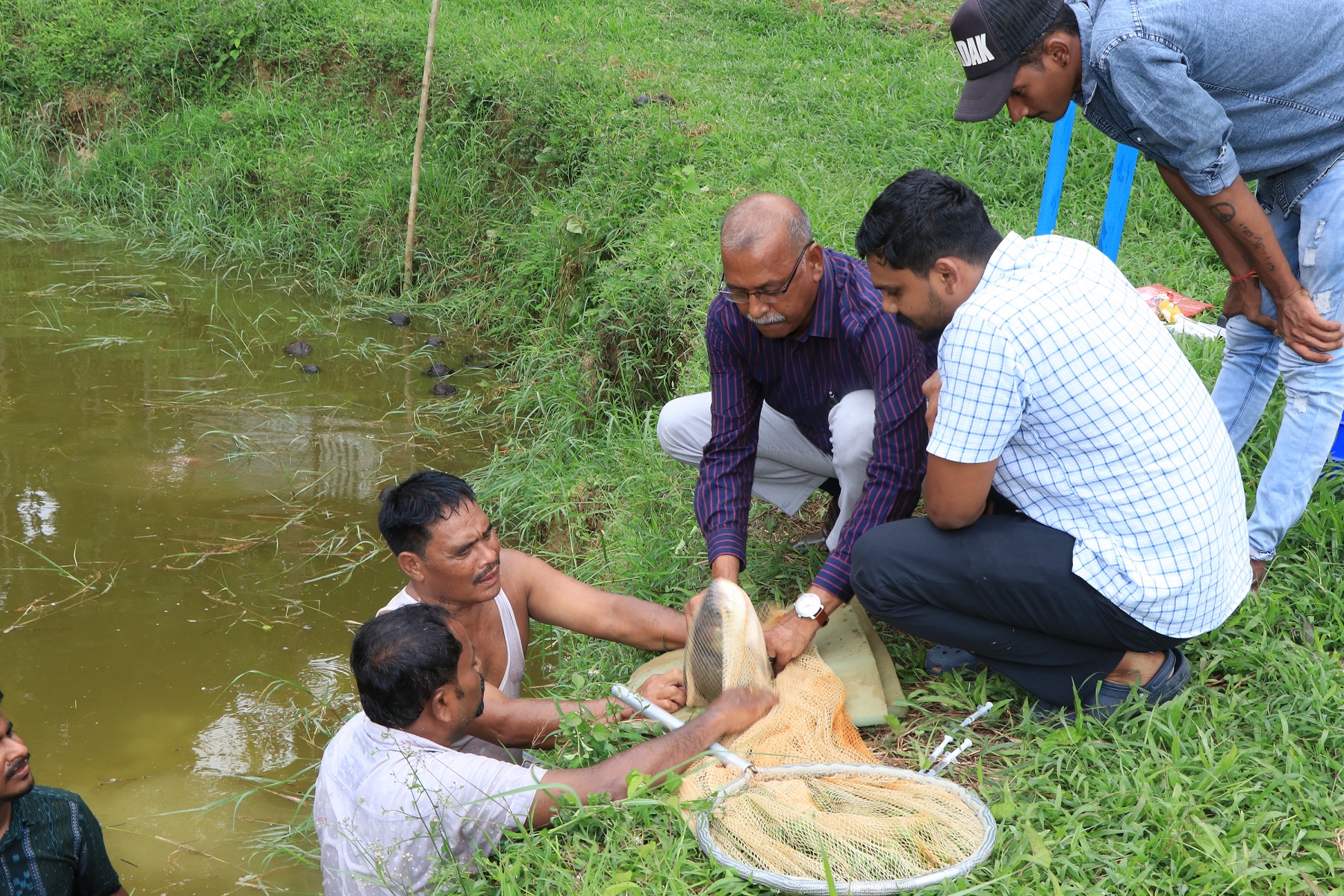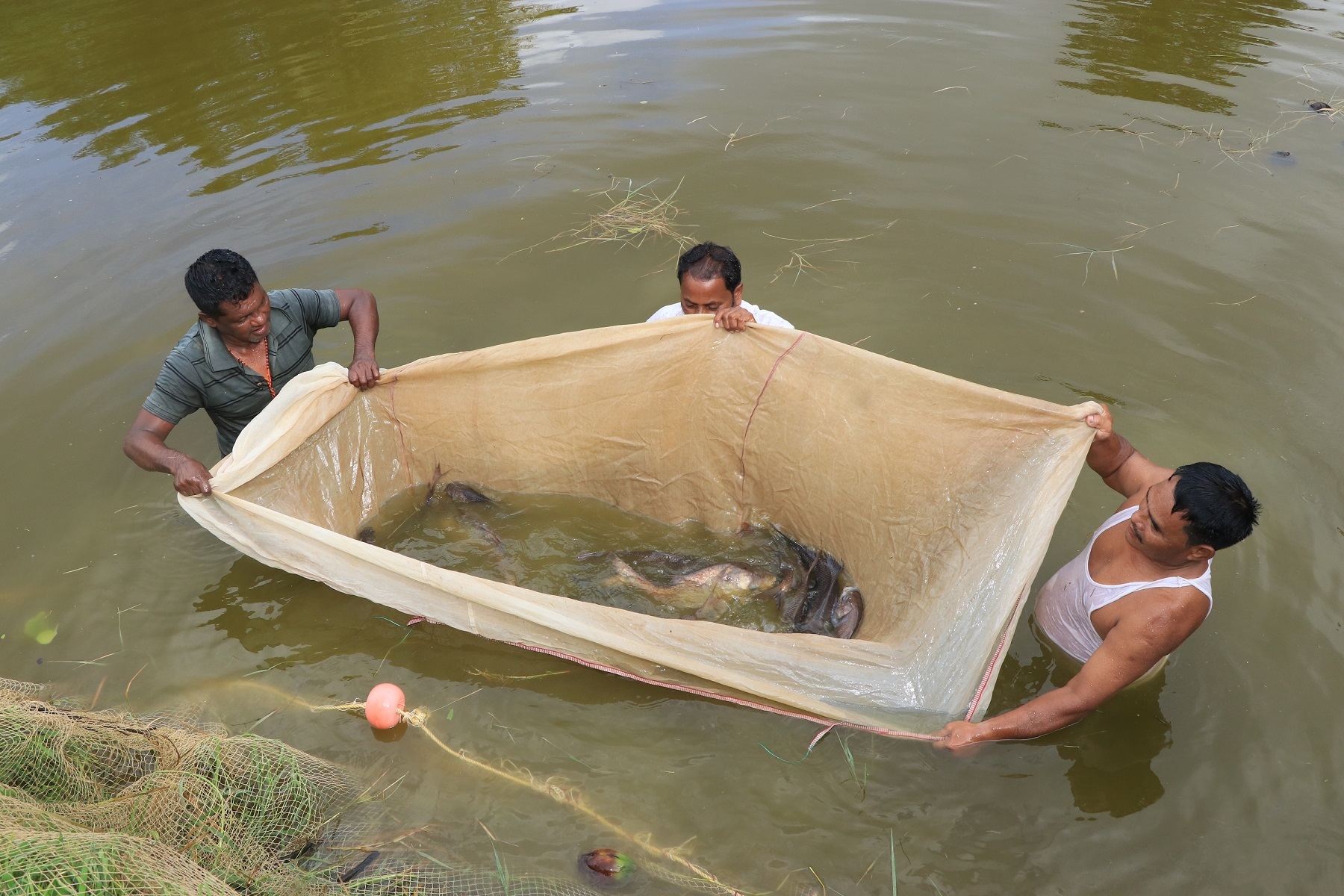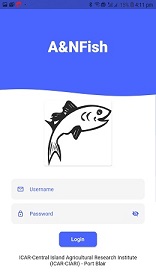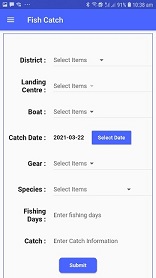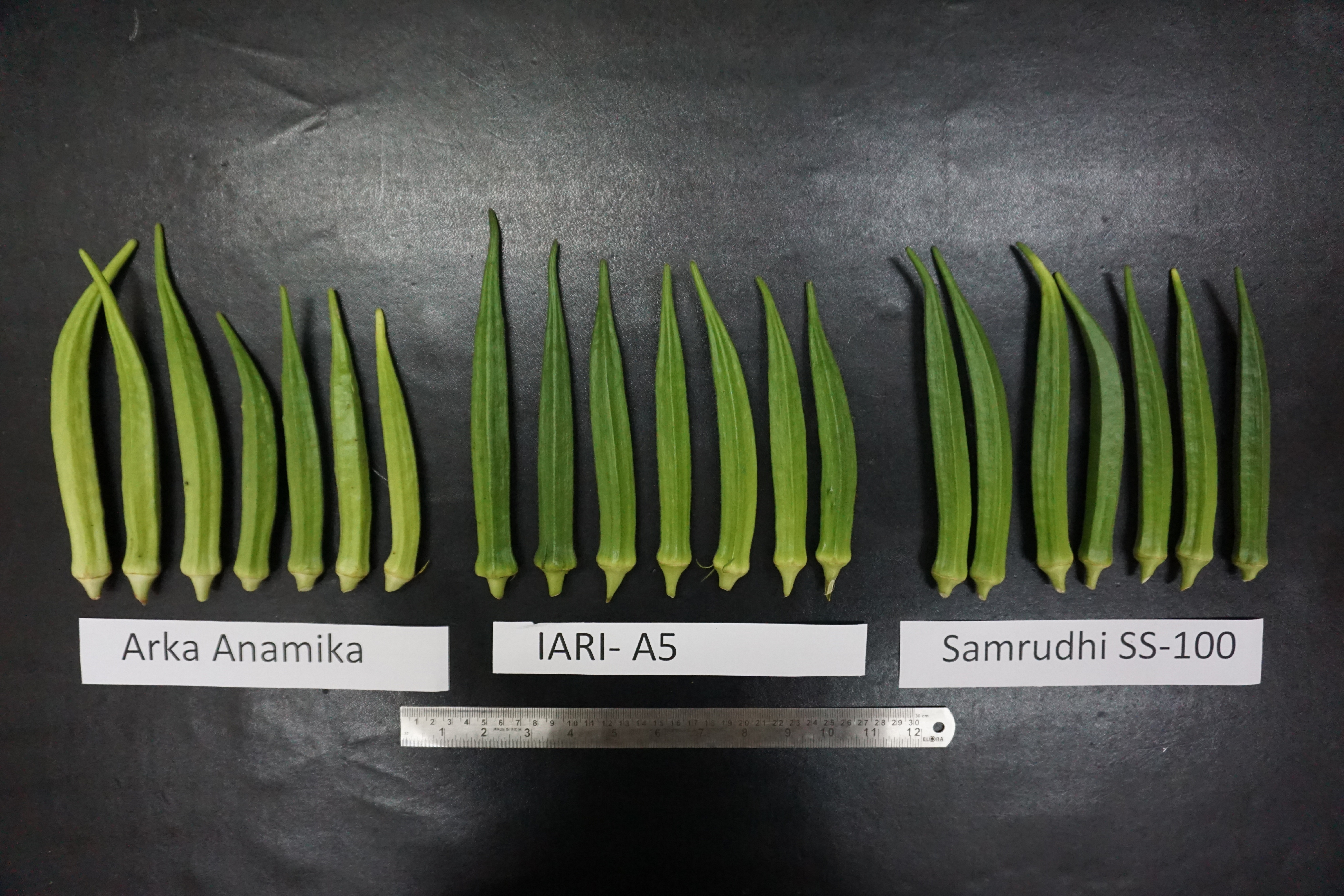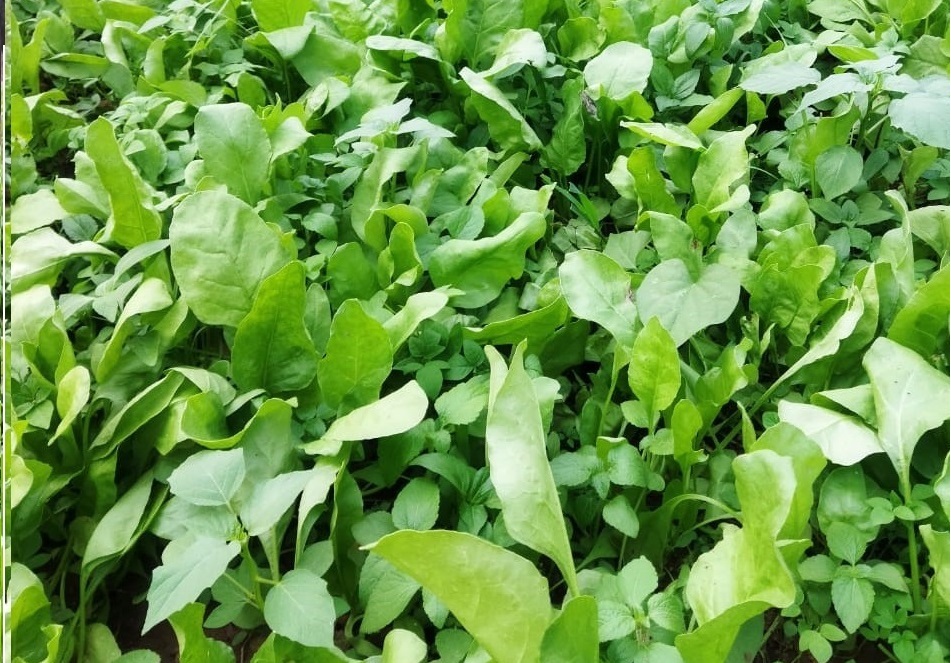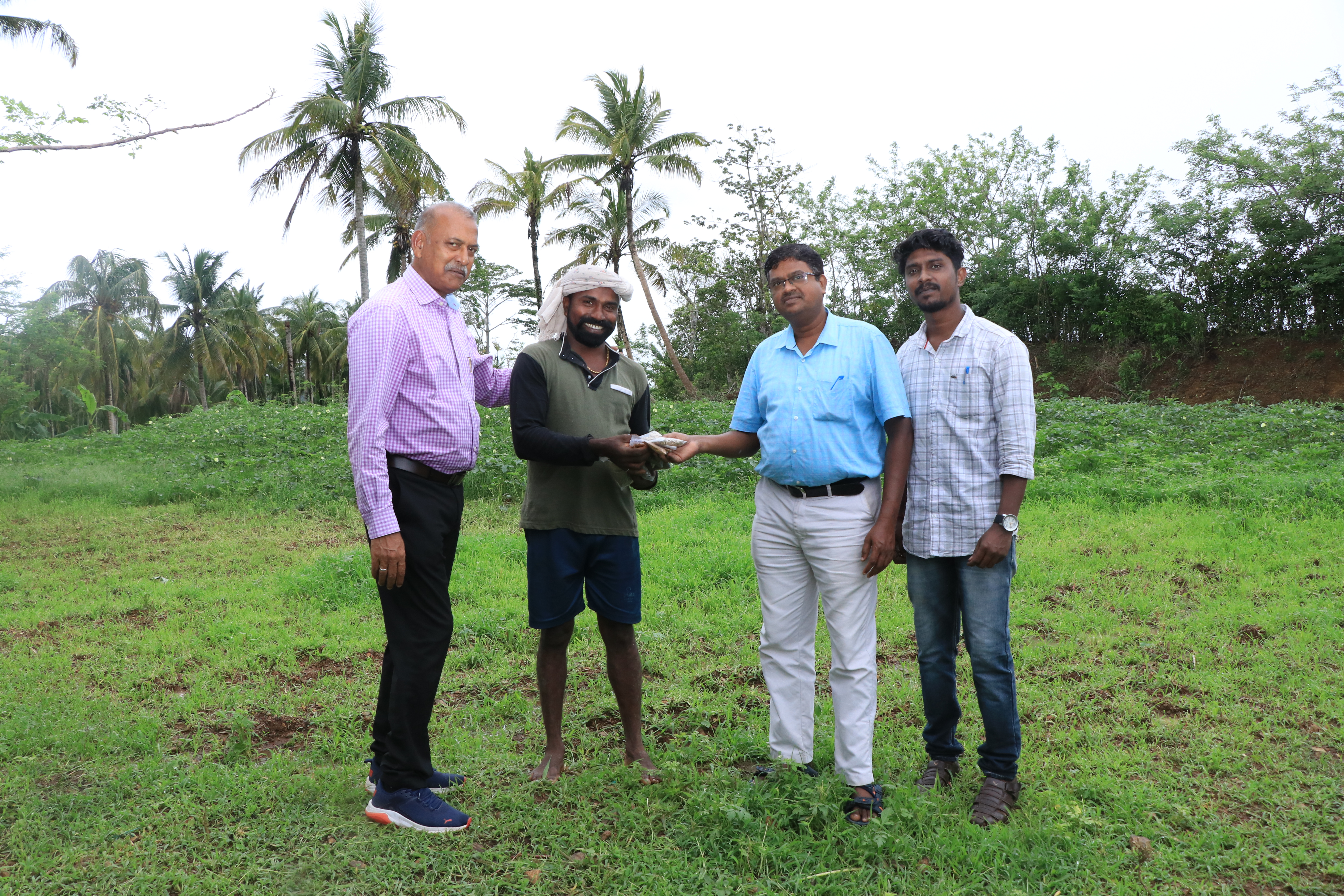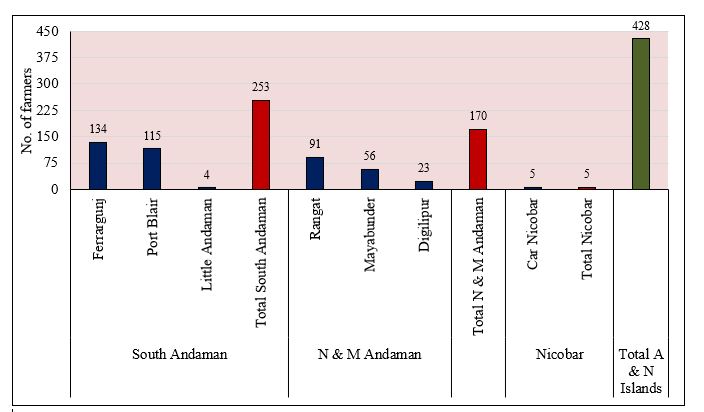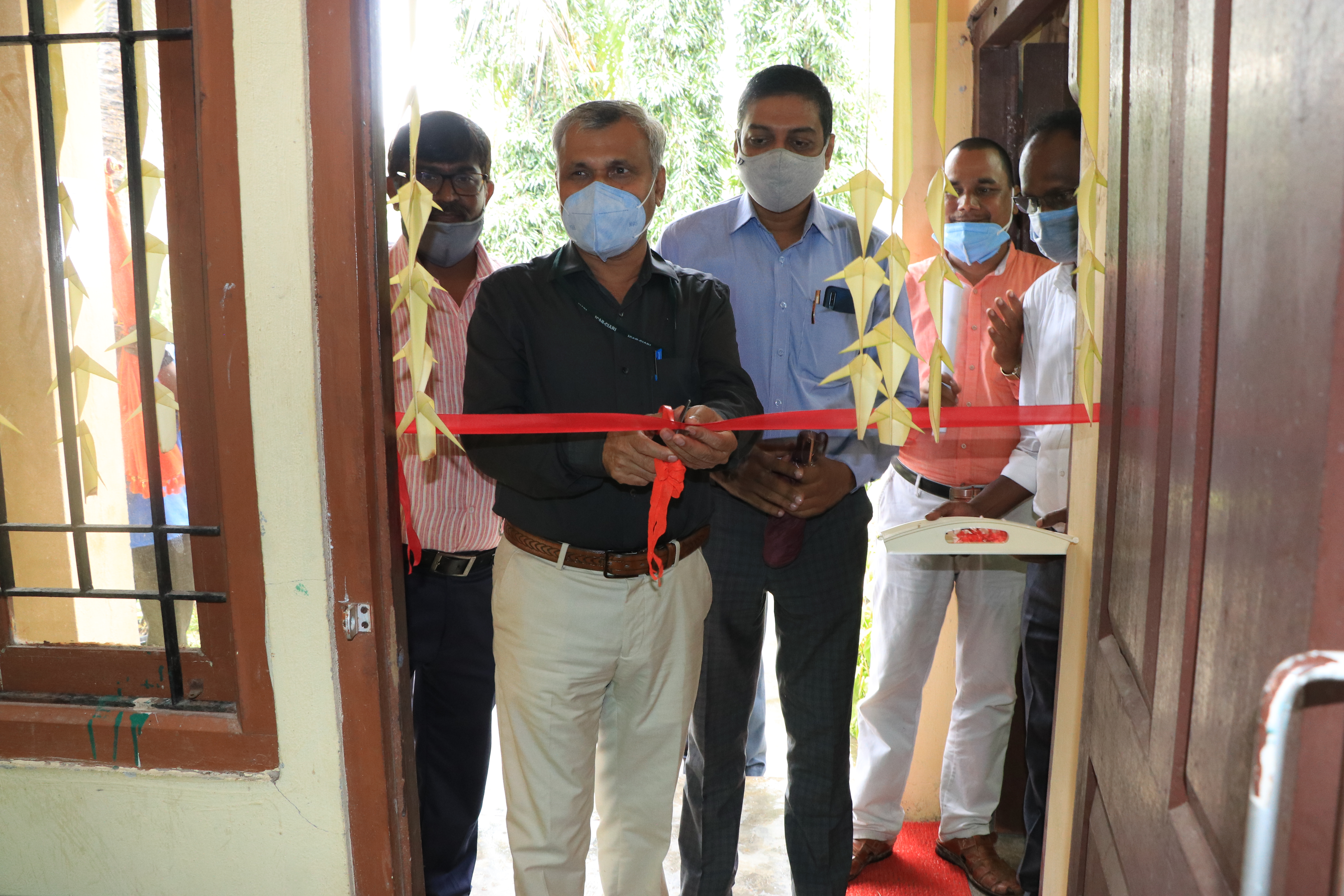| Thematic wise Achievements |
|||||||||||||||||||
|---|---|---|---|---|---|---|---|---|---|---|---|---|---|---|---|---|---|---|---|
| Aquaculture |
|||||||||||||||||||
| Fish feed production unit was established by ICAR-CIARI with a production capacity of 80 to 100 kg per hour. |
|||||||||||||||||||
| Dweep-Carp Grower Feed was developed which can be fed to the Indian Major Carps from fingerlings to marketable size. |
|||||||||||||||||||
| Baseline data has been collected and compiled from a total of 1174 fish farms located in Andaman and Nicobar Islands and necessary advices on better management practices were provided to the fish farmers. |
|||||||||||||||||||
| Reported the dual infection of Infectious Hypodermal and Hematopoietic Necrosis Virus (IHHNV) and White Spot Syndrome Virus (WSSV) in wild marine shrimps and crabs of Andaman and Nicobar Islands. |
|||||||||||||||||||
| Occurrences of various freshwater and marine fish & shellfish parasites and incidences of bacterial & fungal infections were reported from Andaman and Nicobar Islands. |
|||||||||||||||||||
| An ornamental fish hatchery involved in breeding and seed production of 12 strains of fishes has been established. |
|||||||||||||||||||
| The impact of COVID-19 pandemic on freshwater aquaculture sector has been studied from stakeholders across the Islands and a policy framework was developed for sustainable aquaculture sector. |
|||||||||||||||||||
| An vertical mud crab fattening unit was developed to fatten the water crabs. |
|||||||||||||||||||
| An indoor biofloc unit was developed for the culture of finfishes and shellfishes. |
|||||||||||||||||||
| Breeding of Carps at ICAR-CIARI |
|||||||||||||||||||
| Breeding of Indian major carp like Catla and Rohu has been attempted in ICAR-CIARI at Bloomsdale and Garacharma farms. The hapa breeding method was performed by selecting brood fishes based on maturity status. The weight of male and female fishes was measured and injected with Gonopro-FH inducing hormone @ 0.3 ml/kg body weight and @ 0.5 ml/kg body weight for males and females, respectively. The breeding hapa (box shape) of dimension 2mx1mx1.2m was fixed in the inner pond margin by wooden pegs. Around 8.5 kg of Catla female and 4 kg of Rohu female brooder were injected for breeding. The ratio of female to male fish was taken 1:2 ratio. The next day morning, the eggs from the breeding hapa were collected and the number of eggs, and fertility were measured. A total of 4.5 lakhs of Catla fertilized eggs and 1.6 lakhs of Rohu fertilized eggs were produced from the brooders. The eggs were kept in hatching hapa for 3 days. The hatching hapa has an inner hapa (2 to 2.5 mm mesh size) and an outer hapa 0.5 mm mesh size. After 24 hr, the inner hapa was removed and the hatchling was kept for yolk sac absorption. Spawn from outer hapa. Around 1.9 to 2 lakh spawn were harvested and stocked in a nursery pond of 300 m2. Before spawn stocking, the nursery pond was manured with cow dung @ 30 kg followed by fermented manure of rice bran and oil cake for zooplankton growth. |
|||||||||||||||||||
| Standardization of freshwater aquariculture practices to promote livelihood and employment opportunities in South Andaman |
|||||||||||||||||||
| New strains of Betta splendens namely, Black Samurai (BS), Dumbo Ear (DE), Giant Plakat (GP) and Yellow Dragon (YD) have been procured from mainland for seed production. Three strains namely, BS, DE and YD were successfully bred and seed production techniques were standardized. Broodstocks of goldfishes, Neon Tetras, and Angel fishes were developed for breeding in the pre-monsoon. Native aquatic ferns, mosses, Crepidomanes sp. were collected and its cultivation techniques were standardized for propagation. |
|||||||||||||||||||
| Aquatic Biodiversity |
|||||||||||||||||||
| A total of 56 species of finfishes inhabiting insular freshwater bodies have been documented from the Andaman and Nicobar Islands |
|||||||||||||||||||
| A new species of snakehead species ‘Channa royi’ has been discovered and described from the Andaman Islands. |
|||||||||||||||||||
| A total of 20 COX-I gene sequences has been generated for the freshwater fishes of Andaman Islands. |
|||||||||||||||||||
| A new species of eel ‘Gymnothorax andamanensis’ has been discovered from South Andaman Islands. |
|||||||||||||||||||
| Baseline assessment of marine debris was studied from the fish landing centers of South Andaman Island. |
|||||||||||||||||||
| Coastal Bio-resource Management |
|||||||||||||||||||
| Augmenting livelihood, resilience, and knowledge generation through coastal fisheries information hub for Nicobar tribes of Car Nicobar Island |
|||||||||||||||||||
| The first baseline information on the prevalence of marine debris in Car Nicobar was reported and published under the project. The surveys revealed that the beaches of Car Nicobar were heavily loaded with plastic debris particularly of foreign origin. Clean Coast Index (CCI) values revealed that the beaches were classified as dirty to extremely dirty category. Coastal cleanup initiatives were taken up in Car Nicobar with the involvement of tribal fishers to generate awareness on the ill effects of plastic litter. Citizen science activities initiated in the Car Nicobar Island through the project revealed better understanding on the seaturtle diversity of Car Nicobar. Sea turtles such as Green turtle (Chelonia mydas), Hawksbill turtle (Eretmochelys imbricata), and Olive ridley turtle (Lepidochelys olivacea) were reported from our surveys in Car Nicobar Island during the period. Local ecological knowledge on the nesting and sea turtle tracks were also collected from the tribal fishermen. The Malayan box turtle (Cuora amboinensis) was recorded from the freshwater streams of Car Nicobar during the period being a rare record of freshwater turtle from Car Nicobar. |
|||||||||||||||||||
| Mapping the brackish water resources of South Andaman for aquaculture site suitability using GIS approach
|
|||||||||||||||||||
| The inundated water bodies in sites such as Sippighat, Flat Bay, Ograbraj, Wandoor, Namunagar, Danduspoint were mapped using the Sentinel-2 images during the period. In-situ field observations on the extent of water spread in the mapped water bodies along with the soil and water sample analysis was being carried out. The coral reefs, mangroves, protected areas, marine national parks, roads etc were also mapped along with the inundated water bodies. The suitability of the inundated waters would be evaluated based on multi criteria decision making approach. |
|||||||||||||||||||
| Deciphering the in-vitro bioactive potential of selected seaweed species of Andaman Islands and evaluation of its immunomodulatory effect on fish
|
|||||||||||||||||||
| Surveys were conducted at Burmanallah and Chidiyatapu coasts of South Andaman and collected the seaweed samples comprising of red (Gracilaria spp., Hypnea sp., Acanthophora sp.), brown (Padina sp., Turbinaria sp., Sargassum sp.) and green seaweeds (Halimeda sp., Dictyosphaeria sp.). Analysed the proximate composition (moisture, ash, carbohydrate, lipid and fibre) for all the collected seaweed species. In-vitro assays such as ABTS (2, 2-Azinobiz-3-Ethylbenthiazoline-6-Sulfonic Acid) and DPPH (1, 1-Diphenyl-2-Picrylhydrazyl) activities were carried out for all the collected seaweed species by using five different solvents such as ethanol, methanol, aqueous, acetone and chloroform. |
|||||||||||||||||||
| Capture fisheries |
|||||||||||||||||||
| The diversity of elasmobranchs (sharks, rays, skates) was studied from the fish landing centers of Andaman Islands. |
|||||||||||||||||||
| Food and feeding studies of major perch fishes were studied from the fish landing centers of Andaman Islands. |
|||||||||||||||||||
| The pandemic impact of the coastal fishermen of Car Nicobar Island were studied through field surveys and personal interviews. |
|||||||||||||||||||
| An inventory of women seafood vendors were prepared through field surveys from South Andaman and Car Nicobar Island. |
|||||||||||||||||||
| Policy brief’s were developed for the sustainable development of marine fisheries sector in the Islands |
|||||||||||||||||||
| A concept of coastal fisheries information hub was developed and launched in Car Nicobar Island to support coastal fishing activities of Nicobar traditional communities in Car Nicobar. |
|||||||||||||||||||
| Prevalence of parasites infesting commercial marine and freshwater fishes of the Andaman Islands |
|||||||||||||||||||
| First report of Ichthyophthirius sp. a protozoan parasite was recorded in native and endemic freshwater fishes of the Andaman Islands for the first time i.e. in Redigobius tambujon and Sicyopterus garra Numerous infective trophonts were attached on the host body surfaces and fins causing mortality This outbreak constitutes the first report of parasitic infestation in native and endemic freshwater fishes of the Andaman Islands. |
|||||||||||||||||||
| Transfer of technology, capacity building, policy support and market intelligence to stake holders |
|||||||||||||||||||
| Behavioural perspective of farmers’ attitude towards farming in ANI |
|||||||||||||||||||
| Challenges before any populous country is to feed its citizens which is most often exacerbated by the problems like high unemployment, low per capita income and low resource development. Agriculture sector is potentially the largest employment providing sector in the country. With the objectives to elucidate the socio-economic characteristics of Island farmers, their attitude towards agriculture, reasons for their fading interest in agriculture and their expectations to sustain farming as an occupation, this study has been undertaken in 2022-23 with 86 randomly selected farmers from different cluster villages across the three districts of Andaman & Nicobar Islands. The results indicated that majority (84.88%) of the farmers are more than 40 years old with middle level of education (33.72%), engaged in full time farming (65.12%), having farming experience of 30 years (74.42%) with nuclear family (51.16%), marginal farm size up to 2.5 acre (43.02%) and annual income of Rs. 50,000 to 1.5 lacs (48.84%). They possessed a low level of social participation (93.11%), extension contact (44.19%) and information seeking behavior (46.51%), but had a high level of economic motivation (69.96%), risk orientation (55.62%) and scientific orientation (75.39%). A total of 51.80 percent respondents exhibited strong attitude towards farming. Out of 12 independent variables, social participation, economic motivation and scientific orientation were highly significant and contributing towards favorable attitude towards agriculture. Five top reasons for fading interest in agriculture were lack of labour with mean Likert score of (3.88) followed by lack of input (3.84), high production cost (3.6), age factor (3.57) and less productivity (3.52). Promotion of agro-eco tourism, area specific crop insurance, school level farm education, subsidization of input cost and implementation of practical and employable higher agricultural education are the way forward to develop positive attitude in farmers towards agriculture. |
|||||||||||||||||||
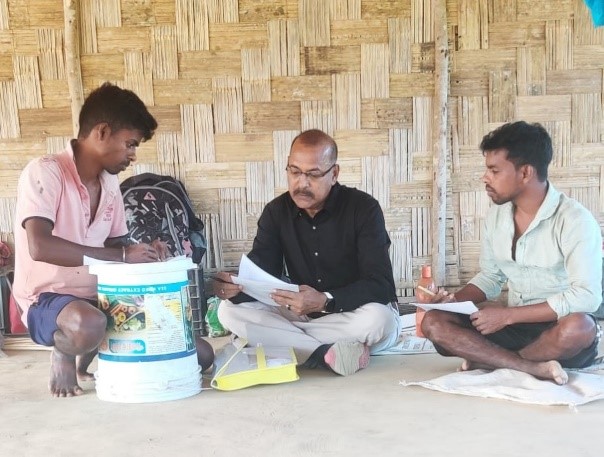
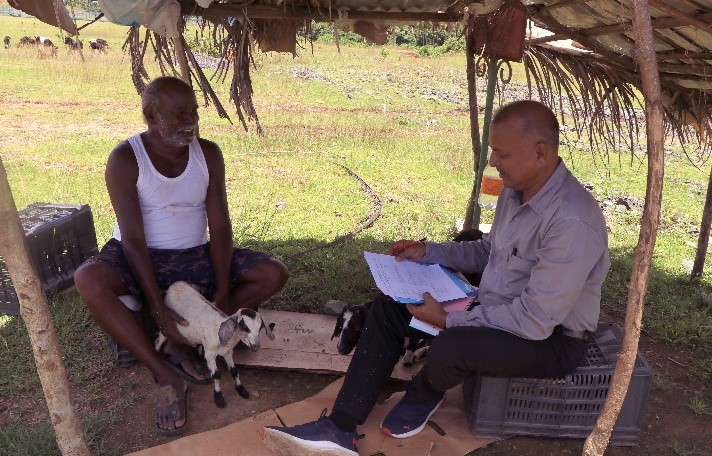
|
|||||||||||||||||||
| Development of Island-based information management system for decision making in agriculture |
|||||||||||||||||||
| ICAR-Central Island Agricultural Research Institute has initiated to develop dedicated Dweep Geoportal to systematically organize and deploy agriculture and allied information in Geographic Information System (GIS). The user interface of dweep Geo-portal was developed using web technologies i.e. HTML, CSS and JavaScript to visualize various point, line and polygon thematic layers on administrative layers (District Boundary, Block Boundary, Socio Economic Data, Demographic information, Land use land cover, Natural resources: Soils, water, etc., Climate and weather, Watershed map, Crop, Livestock and Fisheries data. Spatial layers on Island resources were deployed and provided as Web Mapping Services (WMS) by using the Geoserver platform By hosting GeoServer on Tomcat Web Server. Open Layers, a free mapping library, is integrated into GeoServer to display variety of maps to the user. These layers were stored in PostgreSQL database. All open source Web-GIS tools GeoServer, PostgreSQL and OpenLayers were installed in the local server. |
|||||||||||||||||||
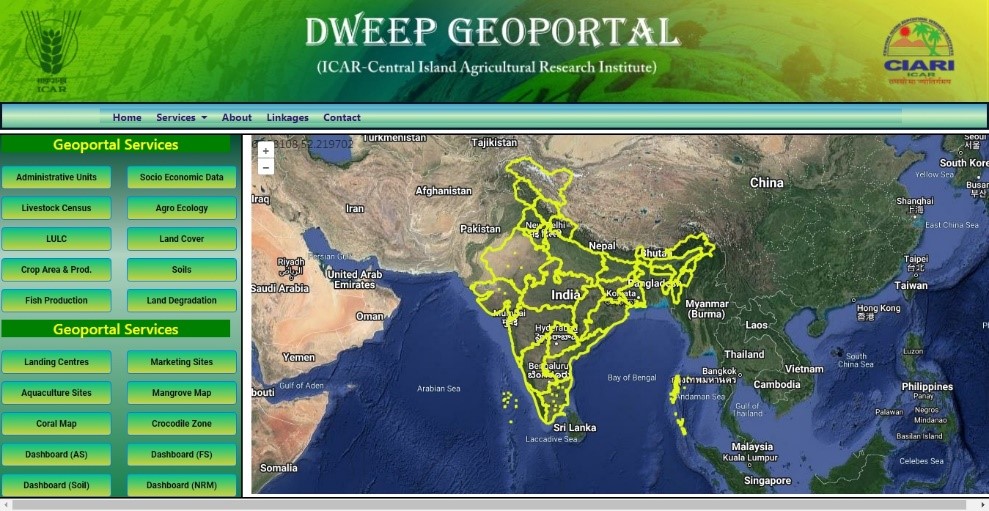
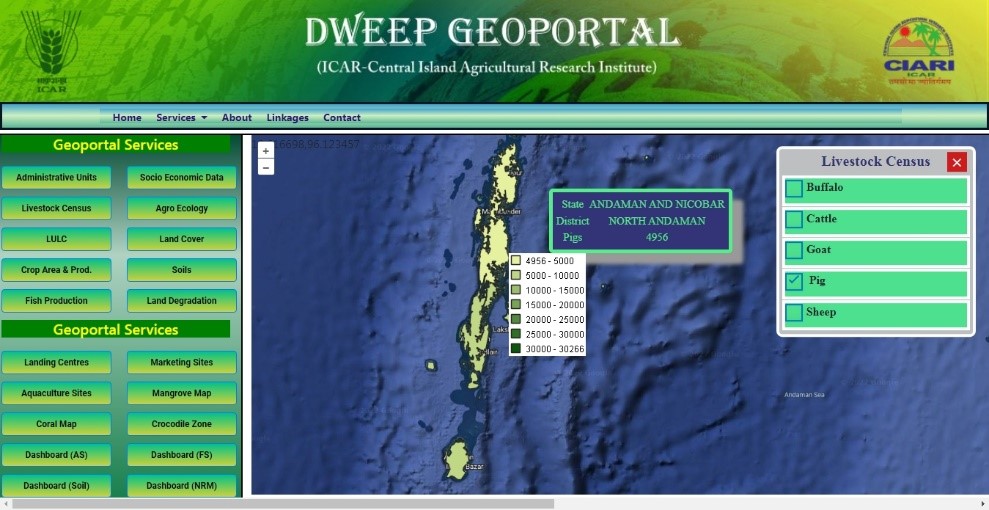
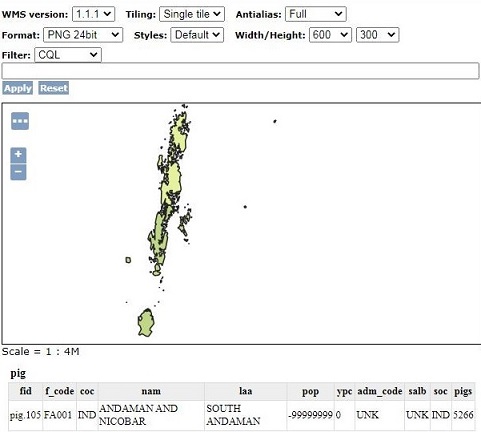
A&N Fish Catch App |
Based on the information collected from the stakeholders, few modules of an innovative fish catch mobile app was developed to systematically record real time marine fish catch data from 51 landing centres across three districts of Andaman and Nicobar Islands. User authentication login page was developed to allow registered users to login to the site and update catch data. The app integrated with web server and MySQL data base server to store and retrieve data on real time have the ability to collect species-wise total catch landed at landing centre, vessel information, fisherman details, fishing effort and gear details. Images and main features of 35 commercially important fish species belong to 3 different groups viz. Pelagic, demersal and oceanic fisheries are available in the app to identify the fishes. This will facilitate to bring all scattered catch data under one roof so that researchers and planners can use this real time data for policy decision. |
|
National Extension Programme of IARI with CIARI |
Kharif 2022-2023 |
Under assessment of on-farm demonstrations and farmers’ feedback to technologies of IARI disseminated through National Extension Programme along with ICAR_CIARI, a total of 11 village clusters at South Andaman were covered for Kharif 2022-2023. 27 demonstration spread over 1.236 ha with crop namely Bhendi var. A5 and Palak var. Pusa Bharati & All green was conducted. The benefit cost ratio was 3.22 for palak var. pusa all green followed by 2.33 for var. pusa bharti against local check of 2.07. In case of Bhendi var. A5 the BC ratio was 6.90 against 5.15 with local check. Palak var. Pusa all green & Bhendi var. A5 was preferred over other varieties by the farmers due to its more acceptance in market by the consumers. |
Rabi 2023-2024 |
Under assessment of on-farm demonstrations and farmers’ feedback to technologies of IARI disseminated through National Extension Programme along with ICAR_CIARI, a total of 3 village clusters at South Andaman were covered for Rabi 2023-2024. 17 demonstration spread over 0.4 ha w with crop namely Bhendi var. A5 and Bottle Gourd var. Pusa Samrudhi & Brinjal var. Pusa Vaibhav was conducted. |
|
Outreach of CIARI technologies to the farmers of ANI an overview |
The research output and proven technologies are disseminated to farmers through various extension activities viz. capacity building programmes, trainings, demonstrations, field days, kisan mela, awareness programme, commercialization. A study conducted to assess the extent of adoption of CIARI technologies among the farmers of Andaman & Nicobar Islands since 2017 revealed that, 59 potential CIARI technologies comprising Horticulture, Crop Science, Fisheries, Animal Science and Natural Resource Management have been adopted by 428 farmers across the three districts of Andaman and Nicobar Islands. Among them, 59.11% of the beneficiaries were from South Andaman, followed by N&M Andaman (39.72%) and Nicobar (1.17%). The highest adoption of technology was in Ferrargunj Tehsil (134 farmers) followed by Port Blair (150 farmers) and Rangat (91 farmers). The highest number of farmers adopted scientific goat farming (143 farmers), Scientific pig management (84 farmers), Mini incubator (49), Tri-Model therapy for Humpsore (42 farmers) followed by black pepper cultivation in arecanut, blood fruit cultivation, roof-top gardening, CIARI Dhan 5, CIARI Mung 1, CIARI Urd 1, Vermicompost, Homestead IFS and carp feed. |
| ||||||||
|
|||||||||||||||||||
| Dweep Sale Counter :An analysis of the visitor’s feedback |
A Feedback Form in Hindi and English was introduced in the Month of July, 2022 to document the impressions of farmers, aspiring entrepreneurs, students, dignitaries etc. visiting the Institute for the purpose of meeting, training, field day, exposure visit, advisory, Mela, inputs, education etc. The outcome for the period from July to September 2022 is manifested below: |
||||||||||||||||||
| Demography of visitors |
|||||||||||||||||||
| During the reporting period, 95 people (71% male and 29% female) from 45 different locations visited the Institute of which 13.7% were from Garacharma, 7.4% from Prothrapur, 5.3% from Tushnabad, 6.3% from Birdline, 4.2% each from Dollygunj and Bathu Basti, 3.2% each from Chouldari, School Line and Haddo followed by Prem Nagar, RGT road, Swaraj Dweep, Brichgunj, Teylerabad, Chennai, Carbin Chowk, Nimbudera, Ograbraj, Ranchi Basti, Manglutan, Sippighat, Chandini Chowk, Dandus point, Aberdeen bazar, Coimbatore, Wimberlygunj, Nayagaon, Brichgunj ,Maccapahad, Goal Ghar, Nayashahar, Shadipur, Southpoint, Austinabad, Stewartgunj, Bundiyadabad, Ferrargunj, Dhanikhari, Manpur, Atlanta Point, Attam Pahad, Dignabad, Aldona Goa, Diglipur, and Wandoor. Among them, 32% people are from private sector 27% Government servants, 17% each from farmer and business category; and 7% students. |
|||||||||||||||||||
| Purpose of visit |
|||||||||||||||||||
| Inputs:42% of people visited the Institute to purchase ornamental plants, fruit and vegetable seedlings, coconut and arecanut saplings, chicks, breeding buck, piglets and vermicompost. |
|||||||||||||||||||
| Training:26% of people visited to learn the treatment practices of Humpsore disease in cattle, to improve reproduction and production performance in cattle, quail farming, and fancy guppy fish rearing and to know about different varieties of rice with scientific cultivation. |
|||||||||||||||||||
| Exposure Visit:9% of people visited to know about the activities of the Institute, to find out the prices of Arecanut and Coconut seedlings, to gain knowledge about its biodiversity with special reference to medicinal plants. |
|||||||||||||||||||
| Advisory:14% of people visited to learn how to increase milk production in cattle, scientific farm management practices and method to grow Black Pepper and cherries. |
|||||||||||||||||||
| Meeting:5% of people visited the Scientists of the Institute to know about the procedures of forming FPOs through NABARD, and to understand the R & D activities of the Institute. |
|||||||||||||||||||
| Education:4% of people visited to get mentorship regarding entrepreneurship, and to undergo internship programme. |
|||||||||||||||||||
| Suggestion for improvement of services |
|||||||||||||||||||
| The visitors gave the following feedback for the betterment of Institute’s services: |
|||||||||||||||||||
| Power point presentation during trainings should be shared with the participants for future reference |
|||||||||||||||||||
| Training schedule should be widely published through mass media |
|||||||||||||||||||
| A training on quail farming should be conducted |
|||||||||||||||||||
| Sale counter should be facilitated with swipe machine/Gpay/UPI payment for ease of making payments |
|||||||||||||||||||
| All materials/items should be delivered at the Sale Counter itself |
|||||||||||||||||||
| Seating arrangement should be made for the visitors at the Sale Counter
|
|||||||||||||||||||
| The price of coconut and arecanut seedling should be reduced |
|||||||||||||||||||
| To provide the details of goat about its age, pregnancy etc. for efficient rearing |
|||||||||||||||||||
| The variety of orchids, flowering plants and seeds should be available at reduced price |
|||||||||||||||||||
| More public and business people meetings should be conducted |
|||||||||||||||||||
| Time to time awareness programme should be conducted for needy people |
|||||||||||||||||||
| Introduce more variety of plants. |
|||||||||||||||||||
| Need more variety of banana |
|||||||||||||||||||
| Introduce Jamun seedlings for sale |
|||||||||||||||||||
| Introduce sweet tamarind seedlings for sale |
|||||||||||||||||||
| Some improvement on the display of product could be an additional value /attractions |
|||||||||||||||||||
| Make available seeds according to the season |
|||||||||||||||||||
| Provide pot mixture for raising potted plants |
|||||||||||||||||||
| Overall grading |
|||||||||||||||||||
| Among the visitors 54% appreciated the services of the Institute by giving Excellent grade, followed by 34% Very Good, 10% good and 2% visitors Needs improvement . | |||||||||||||||||||
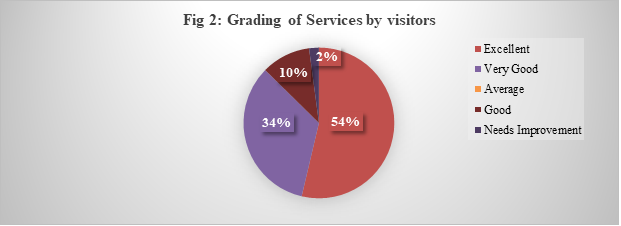
Location of visitors |
|||||||||||||||||||
| Vulnerability studies of Island ecosystem and adaptive strategies to develop climate resilient agriculture |
|||||||||||||||||||
| National Surveillance Programme for Aquatic Animal Diseases (NSPAAD) |
|||||||||||||||||||
| Under the passive surveillance, baseline data has been collected with geo-reference details from a total of 50 freshwater fish farms located at various villages of North and South Andaman. Altogether, nine number of disease cases have been reported due to bacterial, parasitic and fungal pathogens such as Aeromonas veronii, Aeromonas caviae, Dactylogyrus sp., Gyrodactylus sp., Achlya sp., Octolasmis sp., Ichthyophthirius sp. and Paracamallanus sp. Characterized the shellfish parasite, Octolasmis sp. Through DNA sequencing of cytochrome c oxidase subunit 1 (COI) gene. Participated in the inter-laboratory comparison for the molecular detection of three finfish and shrimp pathogens conducted by the coordinating agency, i.e. ICAR-NBFGR, Lucknow. Altogether, three number of awareness programmes were conducted on aquatic animal disease surveillance and health management at South Andaman with 80 number of participants.
|
|||||||||||||||||||
| Study on tribal and non-tribal farmers’ perception about climate change |
|||||||||||||||||||
| Study on the perception of farmers about climate change, its impact and indigenous adaptation strategies has revealed that 68% farmers have experienced decrease in the quantity of monsoon rainfall, increase in summer temperature, increase in chillness and duration of winter, decrease in the duration of monsoon with increase in the occurrence of cyclones, delayed onset and early withdrawal of monsoon. ey are convinced that climate change has adversely affected their farming through decreased yield in paddy and vegetables, increased pest, disease and physiological disorder in vegetables, depletion of water storage structures and increased disease and mortality in livestock. 100% of both tribal and non-tribal farmers practice IFS. 93.3% of tribal and 79.1% of non-tribal famers have changed their livestock management practices with regard to shelter, feed, water etc. 62.8% of non-tribal farmers are manipulating the sowing date in tune with onset of monsoon, only 13.3% of tribal farmers do so. 44.2% of non-tribal farmers change the varieties in accordance to changing climate, only 3.3% of tribal farmers do so. 3.3% of tribal and7% of non-tribal farmers changed their crop; and 6.6% of tribal and 4.7% of non-tribal farmers changed the harvesting date. Apart from this, non-tribal farmers have changed their irrigation management practices (83.7%), land management practices (46.5%) and input management practices (34. 9%).Though 84% of sampled farmers are aware of Pradhan Mantri Fasal Bima Yojana (PMFBY), 48% of them could not insure their crops due to tenancy and undivided ancestral land. He logit analysis on these variables revealed that being tribal, male and more farming experience have increased the perception of farmers about climate change. |
|||||||||||||||||||


